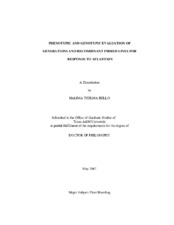| dc.description.abstract | Aspergillus flavus is a fungus pathogen of maize that causes contamination of maize
with aflatoxin. Aflatoxin is a carcinogenic toxin that can cause harm to human and
animal health. Several management practices have been developed, such as cultural,
chemical, biological and breeding, for host resistance. Development of host plant
resistance has been the most desirable but this has been hampered by several factors,
such as environmental influence, time consuming phenotyping and costly inoculation
and field evaluations. Because of the problems associated with breeding for aflatoxin
resistance, heritability estimates along with genetic correlations for aflatoxin and its
secondary traits were estimated in this study. This experiment was conducted in two
Texas locations (College Station and Weslaco) and phenotypic data were collected for
aflatoxin concentration, maturity, endosperm texture, percentage of rotten ears and grain
yield per ear.
The heritability was moderate to high for aflatoxin and secondary traits such as
endosperm texture and percentage of rotten ears. Aflatoxin was observed to be
negatively correlated to grain yield and positively correlated to percentage of rotten ears.
A population of recombinant inbred line derived from a cross between CML161 and
B73o2 were evaluated in replicated trials in two environments for resistance to aflatoxin
contamination. The families were genotyped using simple sequence repeat (SSR)
markers. The mapping Recombinant Inbred Line population was used to detect and
characterize Quantitative Trait Loci associated with aflatoxin accumulation. Alleles for reducing aflatoxin contamination came from both parents across the chromosomes.
Thirty-eight epistatic interactions were detected for aflatoxin resistance.
Several other QTLs were identified for other traits such as grain yield, endosperm
texture, and percentage of rotten ears. The QTLs reported in this experiment are
promising and need to be validated in other environment and genetic backgrounds for
further use in marker assisted selection.
Inheritance studies using generation mean analysis in six crosses showed additive and
dominance effects to be mainly responsible for aflatoxin resistance. Two inbreds,
CML176 and CML161, were identified as sources of resistance in breeding programs
and use for selection. | en |


